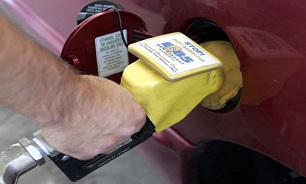Will Alcohol Replace Gasoline?
Under a 2007 law, oil refiners are required to add increasing amounts of ethanol to gasoline.

Khodrocar - The U.S. Environmental Protection Agency on Monday set the final rules for refiners in 2016, ordering them to use 18.1 billion gallons of ethanol, an 11 percent increase from 2014′s levels, but less than what the law originally called for. Janet McCabe, the acting assistant administrator for EPA’s Office of Air and Radiation, called the biofuels industry "an incredible American success story,” saying it was cutting carbon pollution and oil imports while boosting jobs.
Every new vehicle sold today, and most of those still on the road, can safely burn gasoline with up to 10 percent ethanol. "Flex-fuel” vehicles can burn 85 percent ethanol fuel, and come with a bright yellow fuel cap to alert owners that such blends won’t harm the vehicle.
The trouble? E85 is a tiny sliver of national fuel sales, and between its highly variable price and lower energy content per gallon, most buyers with E85-capable models never put it in their tanks. In order to meet the rising mandates for selling more ethanol, at some point oil companies will have to mix more than 10 percent ethanol into everyday fuels—a milestone known as "the blend wall.”
Ethanol backers have been pushing for years to sell fuels with 15 percent ethanol as a logical step over the blend wall, and hailed Monday’s rule as a move in that direction.
But automakers have a different view. Most every vehicle made before 2001 can’t use more than 10 percent ethanol fuel without risking engine or fuel system damage (ethanol can corrode rubber in fuel lines.) While the EPA has said vehicles made after 2001 should be OK, automakers have disagreed, warning that unless they say so, E15 or other blends would harm their models and possibly void warranties.
And many automakers still say no. Between the 2001 and 2011 model years, only E85-capable flex-fuel models and Porsches were certified as E15-compliant. Since then, other automakers have jumped on board, but slowly; Chrysler just OK’d E15 fuels for its 2016 models after warning against its use in 2015 vehicles. Those warnings are often buried in the owner’s manuals, such as in the 2016 Nissan Rogue, which tells its owners that E15 "will adversely affect the emission control devices and systems of the vehicle and should not be used”—adding that any damage won’t be covered by warranty.
As long as gas prices stay low, it’s unlikely that many Americans will see E15 at the pump. But gas prices aren’t exactly easy to predict, and even if demand stays high, federal laws will eventually require more ethanol in your tank beyond 2016. If you don’t know whether your vehicle should use it, the best way to find out is in your glovebox—and the best time for doing so is sooner than you think.
Source: Yahoo News
Every new vehicle sold today, and most of those still on the road, can safely burn gasoline with up to 10 percent ethanol. "Flex-fuel” vehicles can burn 85 percent ethanol fuel, and come with a bright yellow fuel cap to alert owners that such blends won’t harm the vehicle.
The trouble? E85 is a tiny sliver of national fuel sales, and between its highly variable price and lower energy content per gallon, most buyers with E85-capable models never put it in their tanks. In order to meet the rising mandates for selling more ethanol, at some point oil companies will have to mix more than 10 percent ethanol into everyday fuels—a milestone known as "the blend wall.”
Ethanol backers have been pushing for years to sell fuels with 15 percent ethanol as a logical step over the blend wall, and hailed Monday’s rule as a move in that direction.
But automakers have a different view. Most every vehicle made before 2001 can’t use more than 10 percent ethanol fuel without risking engine or fuel system damage (ethanol can corrode rubber in fuel lines.) While the EPA has said vehicles made after 2001 should be OK, automakers have disagreed, warning that unless they say so, E15 or other blends would harm their models and possibly void warranties.
And many automakers still say no. Between the 2001 and 2011 model years, only E85-capable flex-fuel models and Porsches were certified as E15-compliant. Since then, other automakers have jumped on board, but slowly; Chrysler just OK’d E15 fuels for its 2016 models after warning against its use in 2015 vehicles. Those warnings are often buried in the owner’s manuals, such as in the 2016 Nissan Rogue, which tells its owners that E15 "will adversely affect the emission control devices and systems of the vehicle and should not be used”—adding that any damage won’t be covered by warranty.
As long as gas prices stay low, it’s unlikely that many Americans will see E15 at the pump. But gas prices aren’t exactly easy to predict, and even if demand stays high, federal laws will eventually require more ethanol in your tank beyond 2016. If you don’t know whether your vehicle should use it, the best way to find out is in your glovebox—and the best time for doing so is sooner than you think.
Source: Yahoo News
Latest News


